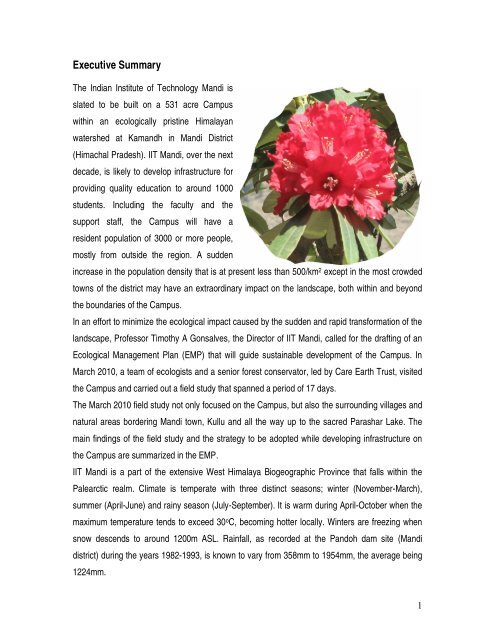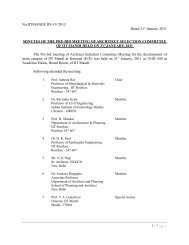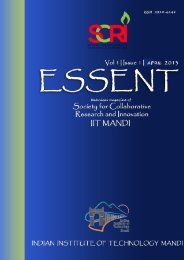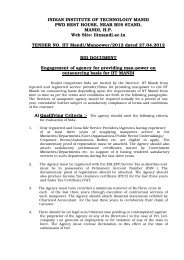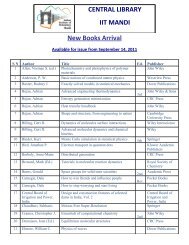Eco Report of the area - IIT Mandi
Eco Report of the area - IIT Mandi
Eco Report of the area - IIT Mandi
Create successful ePaper yourself
Turn your PDF publications into a flip-book with our unique Google optimized e-Paper software.
Executive Summary<br />
The Indian Institute <strong>of</strong> Technology <strong>Mandi</strong> is<br />
slated to be built on a 531 acre Campus<br />
within an ecologically pristine Himalayan<br />
watershed at Kamandh in <strong>Mandi</strong> District<br />
(Himachal Pradesh). <strong>IIT</strong> <strong>Mandi</strong>, over <strong>the</strong> next<br />
decade, is likely to develop infrastructure for<br />
providing quality education to around 1000<br />
students. Including <strong>the</strong> faculty and <strong>the</strong><br />
support staff, <strong>the</strong> Campus will have a<br />
resident population <strong>of</strong> 3000 or more people,<br />
mostly from outside <strong>the</strong> region. A sudden<br />
increase in <strong>the</strong> population density that is at present less than 500/km 2 except in <strong>the</strong> most crowded<br />
towns <strong>of</strong> <strong>the</strong> district may have an extraordinary impact on <strong>the</strong> landscape, both within and beyond<br />
<strong>the</strong> boundaries <strong>of</strong> <strong>the</strong> Campus.<br />
In an effort to minimize <strong>the</strong> ecological impact caused by <strong>the</strong> sudden and rapid transformation <strong>of</strong> <strong>the</strong><br />
landscape, Pr<strong>of</strong>essor Timothy A Gonsalves, <strong>the</strong> Director <strong>of</strong> <strong>IIT</strong> <strong>Mandi</strong>, called for <strong>the</strong> drafting <strong>of</strong> an<br />
<strong>Eco</strong>logical Management Plan (EMP) that will guide sustainable development <strong>of</strong> <strong>the</strong> Campus. In<br />
March 2010, a team <strong>of</strong> ecologists and a senior forest conservator, led by Care Earth Trust, visited<br />
<strong>the</strong> Campus and carried out a field study that spanned a period <strong>of</strong> 17 days.<br />
The March 2010 field study not only focused on <strong>the</strong> Campus, but also <strong>the</strong> surrounding villages and<br />
natural <strong>area</strong>s bordering <strong>Mandi</strong> town, Kullu and all <strong>the</strong> way up to <strong>the</strong> sacred Parashar Lake. The<br />
main findings <strong>of</strong> <strong>the</strong> field study and <strong>the</strong> strategy to be adopted while developing infrastructure on<br />
<strong>the</strong> Campus are summarized in <strong>the</strong> EMP.<br />
<strong>IIT</strong> <strong>Mandi</strong> is a part <strong>of</strong> <strong>the</strong> extensive West Himalaya Biogeographic Province that falls within <strong>the</strong><br />
Palearctic realm. Climate is temperate with three distinct seasons; winter (November-March),<br />
summer (April-June) and rainy season (July-September). It is warm during April-October when <strong>the</strong><br />
maximum temperature tends to exceed 30 o C, becoming hotter locally. Winters are freezing when<br />
snow descends to around 1200m ASL. Rainfall, as recorded at <strong>the</strong> Pandoh dam site (<strong>Mandi</strong><br />
district) during <strong>the</strong> years 1982-1993, is known to vary from 358mm to 1954mm, <strong>the</strong> average being<br />
1224mm.<br />
1


